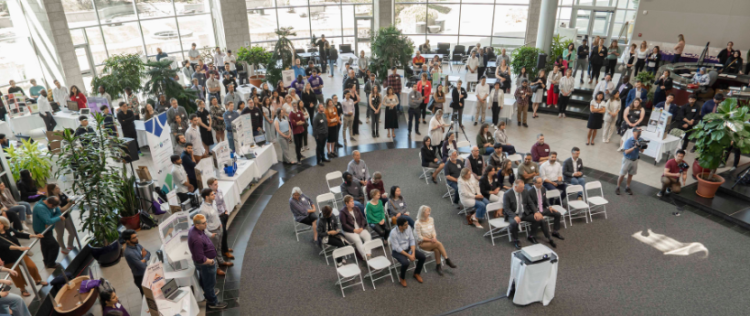Saskatchewan Polytechnic's Applied Research Student Showcase celebrated 76 projects focused on solving real-world problems. Projects were adjudicated by faculty, industry and community partners.

"We are excited to share the work of so many students contributing to applied research at Sask Polytech," says Dr. Susan Blum, associate vice-president, Applied Research and Innovation. "Our showcase continues to grow, with students showcasing projects that address a wide variety of topics. Our faculty encourage and support students to partner with business, industry and the community on applied research projects that provide real-world solutions to today's challenges. We are preparing the leaders of tomorrow for success in the communities and economies of the future. Congratulations to this year's participants and winners. You are leading the way!"
Of the participating students, 105 presenting projects at this year's showcase are recipients of the Saskatchewan Innovation and Opportunity Applied Research Scholarship, made possible by the Government Saskatchewan. Other students presented capstone projects, which are final assignments and part of their academic program, and student research conducted through the Digital Integration Centre of Excellence (DICE) and Centre for Health Research, Innovation & Scholarship (CHRIS).
2024 Applied Research Student Showcase Winners
HEALTH AND SOCIAL
First ($1,000)
Sonuyesh Upreti & Jilu Puttoor Shaju
Autism detection using machine learning
Description: Detecting Autism Spectrum Disorder (ASD) early is crucial for efficient intervention. The primary goal is to create a machine learning model capable of accurately identifying autism in its initial stages.
Second ($800)
Namitha Paul
Artificial Intelligence and Data Analytics
Sign language recognition
Description: There's a need for technology that can understand and identify sign language gestures, bridging communication between the deaf community and others. Specifically, the project aims to close the communication divide between sign language users and non-users by creating a dependable and effective system for recognizing and interpreting sign language gestures.
Third ($500)
Morgan Hale
Exploring rural veterinarian mental health: an integrative literature review
Description: There is clear evidence of mental health issues among veterinary professionals in Saskatchewan. This research aims to facilitate the development of mental health support for rural veterinarians in the province.
SUSTAINABILTY AND ENVIRONMENT
First ($1,000)
Bichu Sajeev
Civil Engineering Technologies (Water Resources option)
A case study of well water treatment solutions in Baildon, Sask
Description: The Baildon ground water has been found to contain heavy metals such as arsenic, iron and magnesium. This project aims to detect these impurities in the well water and construct a purification system to ensure the water is safe for drinking and other household purposes.
Second ($800)
Kimberly Roberts
Integrated Resource Management
Fish Passage Barriers on The Sturgeon River
Description: This project aims to address the lack of information regarding barriers to fish movement in Saskatchewan, specifically focusing on the Sturgeon River. The objectives are to identify and evaluate two potential physical barriers affecting fish and other aquatic species, then provide recommendations to improve fish passage in that area.
Third ($500)
Mitchie Anne Richelle Kenept
Predictive functional profiling of bacterial communities in sewage systems
Description: This research project aims to explore the functional potential of microbial communities in Saskatoon's sewage systems. These communities are important for wastewater treatment and understanding their capabilities is crucial for improving treatment efficiency and reducing environmental impact. The research plan includes bioinformatics data processing, statistical analysis and reporting of findings.
TECHNOLOGY
First ($1,000)
Samantha Wolfe
Development of calibration curve for the analysis of sodium, potassium, magnesium, and calcium in brine samples
Description:Mosaic, a potash mining company, uses brine solutions in their refining process. Ensuring product efficiency requires monitoring the brine's chemical makeup. This initiative focuses on creating a calibration curve for analyzing brine samples to reduce product wastage. The results will be used by chemical engineers to control these parameters and optimize product yield.
Second ($800)
Nathan Kemp & Jinghai Wang
Vertical landing rocket
Description: To design a handheld model rocket that uses CO2 cartridges for propulsion and is capable of self landing vertically. The strategy involves developing a testing setup to assess the feasibility of CO2 cartridges as propellants and to optimize nozzle design.
Third ($500)
Linden Herperger & Jacob Murphy
Design and Manufacturing Engineering Technology
CNC plasma device for sheet metal decoiler
Description: To design and create a plasma CNC cutting device for use in a sheet metal preparation operation. The research plan includes analyzing T.W. Enterprises' existing operation to determine the most time and cost effective solution before diving into an initial design phase.
PEOPLE'S CHOICE
People's choice ($500)
Siddh Bhadani, Jashanjeet Singh, Elvis Obiakor, Jack McKinnon, Matthew Kettering, Janus De Guzman
Team Black (AI integration)
Description: In the realm of education, there are ongoing challenges related to producing, distributing and evaluating educational materials. Despite the progress in artificial intelligence (AI), many educational platforms have yet to fully leverage this technology to improve learning experiences efficiently. Our research aims to tackle these issues by establishing a centralized AI-powered platform where educators and students can easily share and access educational resources. The overarching objective is to ensure that quality education is available to everyone and to equip educators and students with advanced tools to facilitate teaching and learning.
Sask Polytech faculty, researchers and students collaborate with the private and public sector on applied research projects. These projects take many forms including product development, process design, technology adoption and proof of concept. Using state-of-the-art facilities, equipment and faculty expertise Sask Polytech delivers solutions and helps industry to capture new opportunities. Intellectual property for all applied research projects is retained by industry, creating more incentive for future creative engagement and ongoing collaboration.
Sask Polytech is always looking to create more work-integrated learning opportunities for our student researchers. If you have a business challenge you need assistance with, please contact us.
Thank you to our sponsors Innovation Saskatchewan and Google Cloud.
Learn more at saskpolytech.ca/research.










